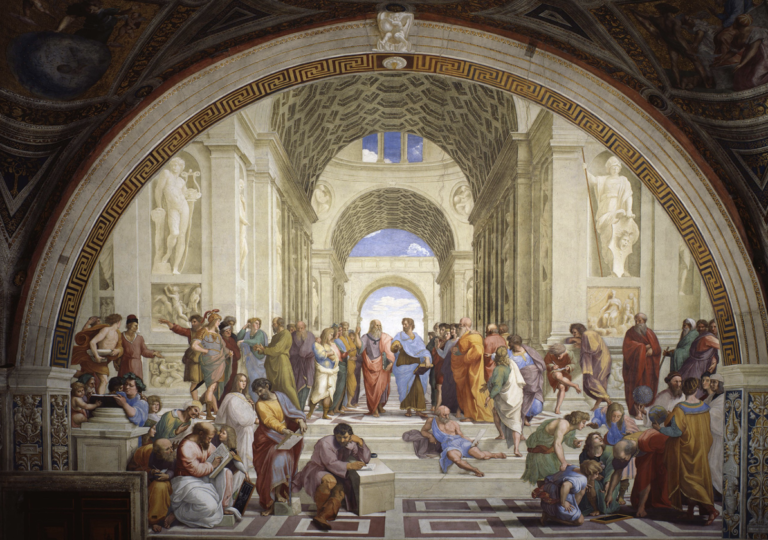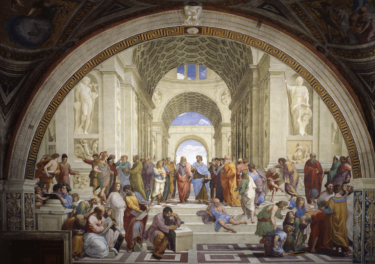はじめに
学生時代に受講して哲学の授業があった。当然、眠い授業だろうと思っていたけど、全然違った。初めてソクラテスの「無知の知」や「よく生きる」を教えてくれたその教授は当時で60歳ぐらいだったけど、シャキシャキしていて、海外留学の経験もあり、英語もネイティブのように上手だったので、カッコイイと思い、ずっと真剣に授業を受けていた。今日はそんな哲学的な動画があったのでこれを選んだ。英語が難解な部分が多かったけど、よければ、視聴してみてほしい。
(出典:YouTube)
ソクラテスとの出会い
今回の動画の主人公は、アテネ出身のギリシャ哲学者であるソクラテス(紀元前470年から399年)だ。ソクラテスは西洋哲学の祖であるが、アテネ社会では孤立した存在だった。紀元前399年の時に、ソクラテスは不敬罪(impiety)と青少年堕落罪(corrupting the youth)で告発され、裁判の末死刑を宣言された。動画ではそんなシーンから始まる。先入観を嫌い、知っているつもりのことでも突き詰めて考えると何も知らないことに目覚め、最大の賢者とは自分の知恵が実際には無価値であることを自覚するものと悟った哲学者である。ソクラテスにとっては死刑に処されるよりも正義に反することがより大きな禍と考えたようだ。ソクラテスにとっては、いかなる場合においても、故意に不正は行わないことが正義であり、知らずに不正を行っていたのであれば、悔い改めるという倫理観だ。
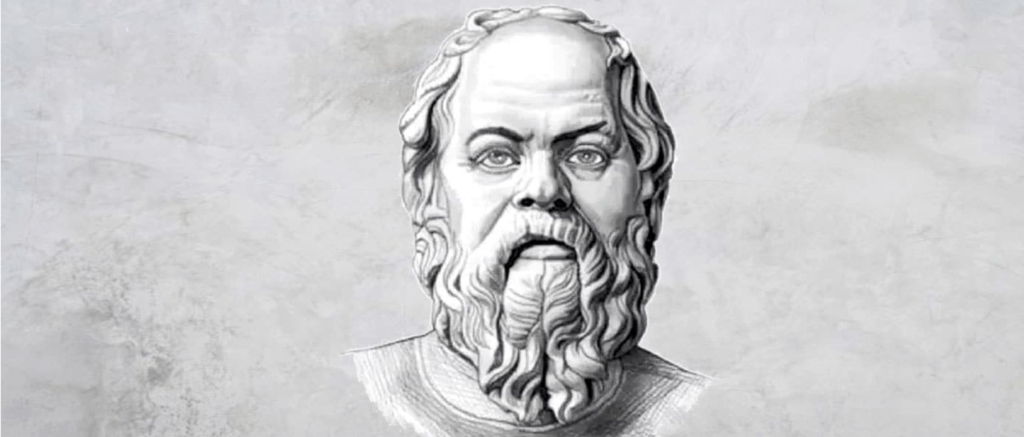
(出典:ethics)
ソクラテスの教え
ソクラテスの代表的な教えの一つに、「The unexamined life is not worth living(吟味されない人生は生きる価値がない)」というのがある。嘘をつくことは正義ではない。しかし、善意の嘘や、戦争で敵を欺くための嘘はどうか。ある前提条件のもとでは正義であったり、不正義であったする。そのようなことをよく理解することが大事だということだと思う。
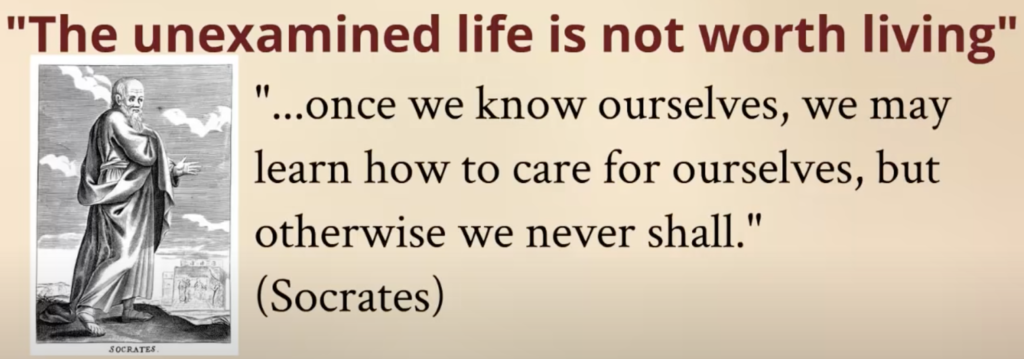
(出典:ethics)
ソクラテスの人間関係
ソクラテスは基本的に書き物を残していない。口述した内容を弟子のプラトンやクセノポンが記録に残した。プラトンにはアリストテレスという弟子がいるが、アリストテレスは現実的な自然哲学や経験哲学を重視する哲学者であり、プラトンは抽象的・理論的な哲学者であり、全く異なる思考と志向をもっている。また、妻であるクサンティッペ(Xanthippe)をソクラテスは悪妻と呼ぶが実際のところは不明だ。ミュルトー(Myrto)という女性もいた。ミュルトーは第2妻という説が有力だけど、これは当時のアテネでは正義だったようだ。
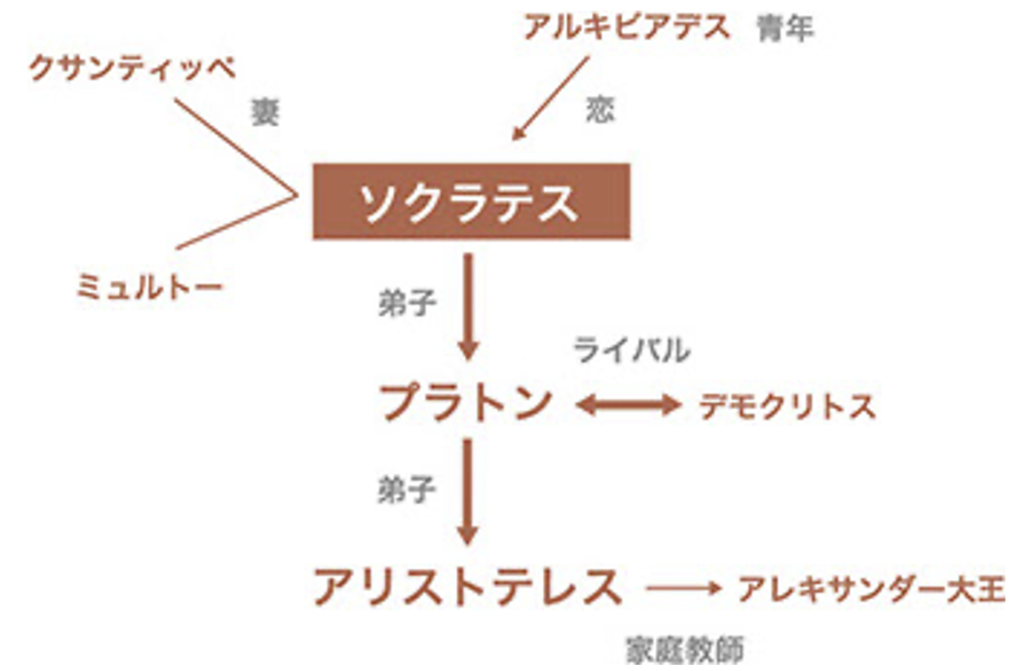
(出典:jnapcc)
アテナイの学堂
ルネッサンスの時代にイタリアの画家ラファエロ・サンティが描いた絵画のうち特に有名なのがアテナイの学堂だ。これは、1509年から1510年にかけてバチカン教皇庁の壁に飾る4つフレスコ画の2番目のもので、ソクラテス、プラトン、アリストテレスを始め著名な哲学者や数学者が多く描かれている。思想的なプラトンは天を差し、現実派のアリストテレスは地を指す構図は有名だ。
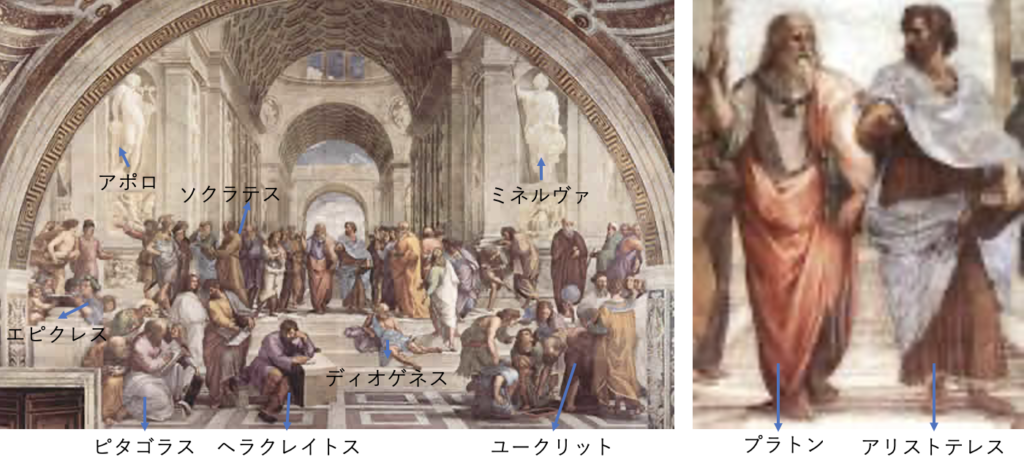 (出典:art-Library)
(出典:art-Library)
数々の教え
ソクラテスの教えは数多い。左上は、「幼少は慎ましく、少年は温和に、成人してからは正しく、老年は思慮深くあれ。」という意味だ。右に移って、「最小のもので満足する者が最も豊かである、満足は自然の富であるからだ。」、「死は人間の最大の恵みかもしれない。」、「無価値な人は飲食のためだけに生き、価値ある人は生きるためにのみ飲食する。」と続く。左下からは、「誰にも何も教えられない。ただ、彼らに考えさせることだけだ。」、「良い妻を持てば幸せになれるし、悪い妻を持てば哲学者になれる。」と少し自虐的なユーモアを感じるものもある。さらに、有名な無知の知と、雄弁を慎めという教訓などを挙げている。これ以外のも色々ある。
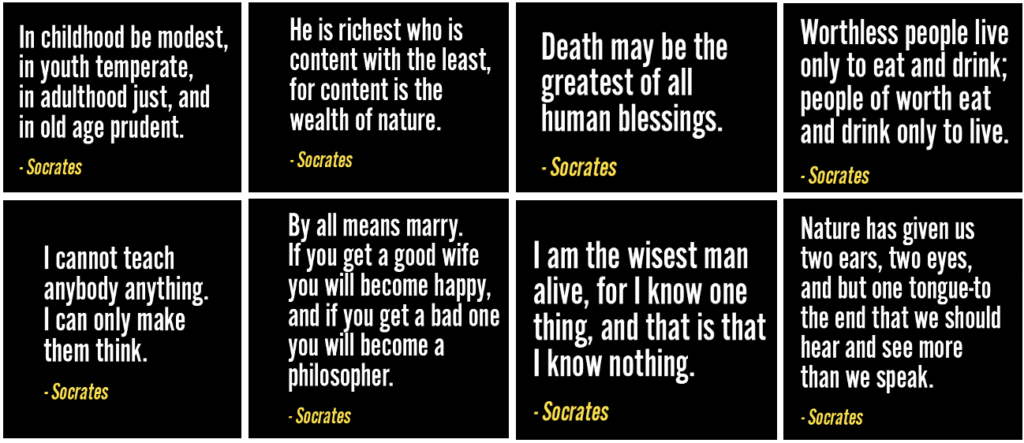
(出典:scrolldroll)
8つの質問
Q1) One reason Socrates was brought to trial was
ソクラテスが裁判にかけられた理由は、不敬罪(impiety)と青少年堕落罪(corrupting the youth)だ。
Q2) In his discussions Socrates often claimed only that
ソクラテスがしばしば用いたのは無知の知なので、”He knew nothing.”だ。
Q3) Two followers wrote about Socrates, Plato and
二人の弟子とは、プラトン(Plato、紀元前427年から紀元前347年)と、クセノポン(Xenophon、紀元前430年から紀元前354年)だ。
Q4) The Supreme Court adopts the Socratic method by formulating insightful
ソクラテスの方法を採用した最高裁の手法とは、仮説の状況(Hypothetical situations)だ。
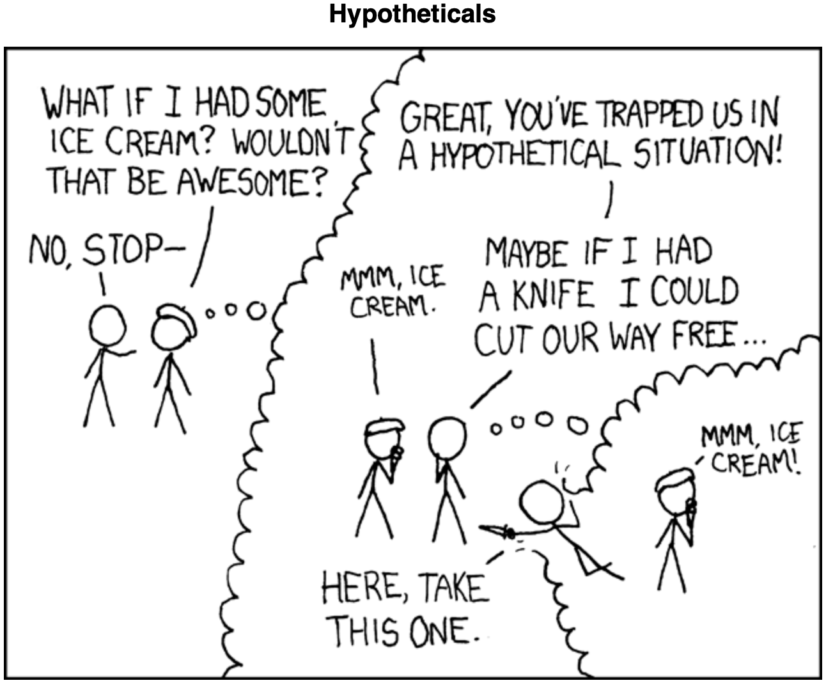
(出典:hypothesical)
Q5) In the Renaissance the Socratic method was adapted to teach
ルネッサンスの時期には、ソクラテスの手法は、臨床医学(clinical medicine)で使われ、学生たちはさまざまな診断の根拠を提案し、医師は彼らの仮定に疑問を投げかけ、議論を促した。
Q6) If Socrates’s questioning did not provide a definitive answer, how was it helpful?
ソクラテスの手法を用いても決定的な答えが出さない場合にも役には立つのかという問いなので、答えは出なくても、いろいろな視点から考えて、さまざまな仮説を検証する中で得られることがあると思う。
Q7) Would you agree with Socrates that “the unexamined life is not worth living”? What does this really mean?
ソクラテスは「吟味されない人生は生きる価値がない」と言いますが、これに同意しますか?この真意は何でしょうかという問いなので、はい、ソクラテスの意見に賛成です。「吟味されない人生は生きるに値しない」とは、あらゆる事柄について常に疑問を持つことで、人はよりよく生きることができるという意味だと理解するので、英語なら次のような感じか。
Q8) Young men in Athens who followed Socrates learned how to question like him. Do you think you could learn how to question like him? Why or why not?
ソクラテスに学んだアテネの若者たちは、質問の仕方を学んだ。あなたは、彼のような質問の仕方を学ぶことができると思いますか?なぜ、または、なぜそうしないのですか?という問いだ。これへの回答は肺でも、いいえでもよい。問題はその理由だ。私はソクラテスのように質問する方法を学んだ。それは自分自身も何に対しても好奇心が旺盛だからです。ソクラテスは必ずしも答えはなくても、多くの質問を持っていることに驚き、親しみを感じたので、英語なら次のような感じだろうか。
まとめ
哲学的な動画は難解だ。ソクラテスのことを描いた動画ということは理解できたが、詳細のワードのヒアリングには限界があり、5分の動画を耐えきれなくて何度かドリームの世界にワープしてしまった(汗)。英語のスクリプトを整理すると理解度は格段に高まる。ディクテーションの前に字幕なしで三回聞くようにしているが、ヒアリング力はまだまだだ。
以上
最後まで読んで頂きありがとうございます。
拝
参考:英文スクリプト
Socrates, one of the founding fathers of Western philosophical thought, was on trial. Many Athenians believed he was a dangerous enemy of the state, accusing the philosopher of corrupting the youth and refusing to recognize their gods. However, Socrates was not feared for claiming to have all the answers, but rather, for asking too many questions. While he loathed(嫌う) formal lectures, the philosopher frequently engaged friends and strangers in lengthy conversations about morality and society.
These discussions were not debates, nor would Socrates offer explicit advice. In fact, the philosopher often claimed to know nothing at all, responding to his partner’s answers only with further questions. But through this process, Socrates probed their logic, revealing its flaws and helping both parties reach a more robust understanding. These insightful(洞察に満ちた) questions made Socrates beloved by his followers. Two of his students, Plato and Xenophone, were so inspired that they replicated their mentor’s process in fictional dialogues. These invented exchanges provide perfect examples of what would come to be known as the Socratic Method.
In one of these fabricated dialogues, Socrates is conversing with a young man named Euthydemus, who is confident that he understands the nature of justice and injustice. Socrates proves the student’s values by asking him to label actions such as lying(嘘) and theft(盗み) as just or unjust. Euthydemus confidently categorizes them as injustices, but this only prompts another question: is it just for a general to deceive or pillage a hostile army? Euthydemus revises his assertion. He claims that these actions are just when done to enemies, and unjust when done to fiends. But Socrates is not finished. He asks the young man to consider a commander lying to his troops to boost their morale.
Before long, Euthydemus is despondent(落胆する). It seems that every answer leads to further problems, and perhaps he is not quite sure what constitutes justice after all. In employing this question-oriented approach, Socrates described himself as a midwife(助産婦), whose inquiries assist others in giving birth to their ideas. His method of questioning draws out an individual’s unexamined assumptions (思い込み) and then challenges those biases. It does not always provide definitive answers, but the method helps clarify the questions and eliminate contradictory or circular logic. And by following a line of inquiry where it logically leads, both the question asker and answerer can end up in unexpected places. This technique is not limited by the conversation’s content, making it incredibly useful in numerous fields.
During the Renaissance, the method was used to teach clinical medicine(臨床医学). Students proposed their rationale for different diagnoses, while a doctor questioned their assumptions and moderated the discussion. In this model, the method could even produce conclusive results. This same approach was later used in other sciences, such as astronomy, botany(植物学), and mathematics. Following the Protestant Reformation, it was adapted to tackle abstract questions of faith. In the 19th century, the method became an essential part of American legal education. Professors explored students’ understanding of judicial reasoning
by challenging them with unforeseen hypothetical situations. This approach is still used today by the Supreme Court to imagine the unintended impacts of passing a law. The Socratic Method can be adapted to teach almost any topic that relies on critical reasoning(批判的推論), but its success depends on the teacher employing it. An effective Socratic educator must be well versed in their subject. Rather than bullying their students or showing off their superior intellect, they should be modest, genuinely curious, and affirming(肯定) of every contribution.
In this regard, Socrates himself may not have been the most subtle Socratic teacher. Historians believe he was deeply critical of Athens’ particular brand of democracy, and known to pass those concerns onto his followers. These subversive(破壊的な) beliefs were distorted in public forums and thought to have inspired two of his pupils to treasonous(反逆的) ends. It was likely for these ideas Socrates was brought to trial, and eventually, sentenced to death. But even on his deathbed artists depict a serene philosopher – ever curious to explore the ultimate question.

